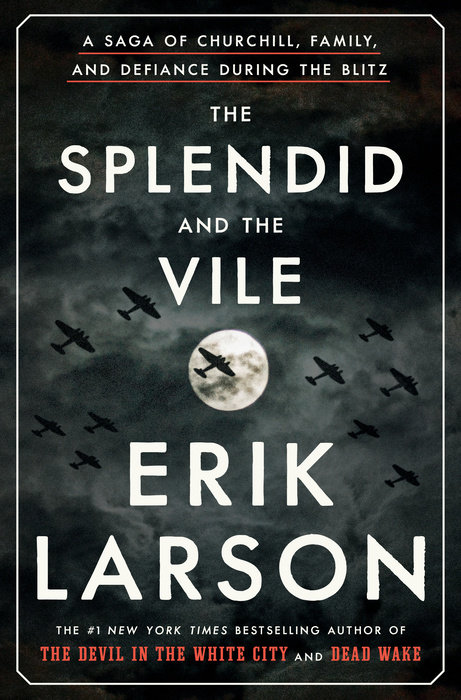The Splendid and the Vile by Erik Larson
Given the enormous number of Churchill biographies, especially of the war years, one might wonder about the necessity of yet another. Eric Larson, author of narrative nonfiction bestsellers The Devil in the White City and In the Garden of the Beasts, takes the vast mountain of Churchill material and tames it into a highly readable, unique book.
In The Splendid and the Vile, Larson focuses narrowly on Churchill’s first year as Prime Minister, May 10, 1940 to May 10, 1941, a time which also coincides with the German air campaign, fifty-seven consecutive nights of bombing following by months of sporadic, increasingly aggressive aerial raids.
It is not a comprehensive account of that time period. Larson takes an intimate look at the day-to-day experiences of the members of Churchill’s circle and ordinary Londoners and how they survived and, in some cases, thrived during that first year.
In Churchill’s immediate family, Larson concentrates on Winston and Clementine’s youngest child, Mary, who kept a diary of the war years. Seventeen years old when the war breaks out, she recounts a life of dances and boys, blackouts and bombastic ministers, usually on the same day.
Other members of the inner circle include Mary’s new sister-in-law, Pamela Churchill, a favorite of Winston’s, and advisors Professor Lindemann and Lord Beaverbrook. Hovering on the fringes is President Franklin Roosevelt with whom Churchill keeps up a steady, calculated correspondence.
Another presence at 10 Downing, Chequers, Churchill’s country retreat, and Ditchley, his wartime retreat, is John Colville, one of Churchill’s five male private secretaries. (Not to be confused with female typists.) Like Mary, John Colville is preoccupied with his love life, his unrequited crush on Gay Margesson, as well as the demands of the war.
Working closely with Churchill, Colville encounters many of Churchill’s famous idiosyncrasies, “his complete lack of personal vanity,” the wardrobe of “rompers” and extravagant dressing gowns, and the nonnegotiable twice daily baths.
He also observes the incubation of Churchill’s speeches. “It is curious to see how, as it were, he [Churchill] fertilizes a phrase or a line of poetry for weeks, and then gives birth to it in a speech.” Churchill often tests his ideas in daily conversation, and keeps a supply of poems and biblical phrases in a special “Keep Handy” file.
Some of the most interesting accounts of daily life come from the Mass-Observation diarists. Launched two years before the war, the Mass-Observation organization recruited hundreds of volunteers to keep a diary with the goal of better understanding ordinary British life. Many kept their diaries throughout the war, and these social observers served as a bench mark of the people’s feelings and anxieties.
The director of Mass-Observation keeps in touch with his team of diarists throughout the year. For example, in rather British understatement, he asks volunteers to make a ranked list of the inconveniences caused by the bombing. Or in December of 1940, there is the request to record how do you feel about the coming year.
For the most part, the Mass-Observation diarists are a stoic bunch. Olivia Crockett’s entries veer from early terror to more resigned acceptance as the year progresses.
Olivia writes of the stress of the bombing, “My heart misses a beat whenever a car changes gear-up, or when someone runs, or walks very quickly, or stares up at the sky…or a door bangs in the wind…So taken all round my heart seems to miss more beats than it ticks!!”
Later, she describes taking a walk during an air raid.
“Walked out into the light of the full moon. Were so thrilled with its beauty we walked to Brixton, through gunfire and all, admiring the effects of shadow and light and liking the empty quiet of the streets.”
Of course, the real hero of the book is Winston Churchill, intelligent, articulate, empathic, hardworking, and above all inspiring. The perfect leader for the crisis, and the perfect crisis for the leader.
Do not miss the Epilogue which describes the post-war activities of the major players and the informative footnotes!
WHAT OTHER REVIEWERS SAY
The New York Times: “Through the remarkably skillful use of intimate diaries as well as public documents, some newly released, Larson has transformed the well-known record of twelve turbulent months, stretching from May of 1940 through May of 1941, into a book that is fresh, fast and deeply moving.”
WHO WROTE IT
Erik Larson is the author of five national bestsellers, Dead Wake, In the Garden of the Beasts, Thunderstruck, The Devil in the White City, and Isaac’s Storm, which have collectively sold more than nine million copies.
Other reading suggestions
Clementine: The Life of Mrs. Winston Churchill by Sonia Purnell
Young Titan: The Making of Winston Churchill by Michael Shelden
Hero of the Empire: The Boer War, a Daring Escape and the Making of Winston Churchill by Candice Millard
